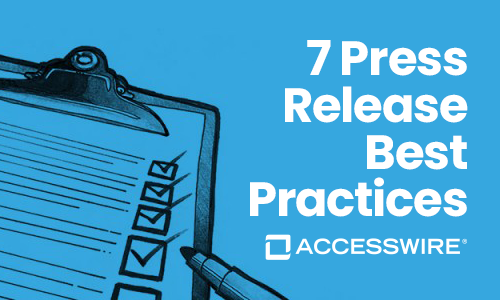Tips on How to End a Press Release
No matter the trade, message, or format, endings are notoriously hard to write. When it comes to press release best practices, the way you conclude your press release can either drive home or discredit the rest of your message—and the integrity of your company in the eyes of the press, and your public.
A busy journalist receives different types of press releases and emails every day, so a relevant, cogent closing paragraph to your press release, along with strategizing the best time to send a press release, can determine whether or not your press coverage will reach a wider audience.
Ideally, the ending of a press release should:
- Hone your brand’s message
- Strike a chord with readers
- Pursue a concrete, predetermined goal
- Tender new relationships
This article will cover the larger anatomy of an effective press release, and what it takes to write a sterling conclusion to seal it off. By following these tips, you’ll be prepared for successful press release distribution.
The Anatomy of a Press Release
In the internet age, attention spans, in general, are on the wane—and journalists’ are no exception.
Press releases should be concise, pithy, and strategically formulated. They typically range between 400 and 500 words long, divided into four or five digestible paragraphs.
Every press release format should include:
- A headline
- A dateline
- An introduction
- A body
- A “boilerplate”
- A CTA (Call to Action)
- Media contact details
Nowadays, many companies also elect to incorporate images, graphics, or visual media into their press releases. These can be an excellent way of piquing your reader’s interest, illustrating your message, and giving your contact more information while maintaining a low press release writing word count.
Why the Ending Matters
The de facto purpose of a good press release is to disseminate company news to the public—but a press release is also a vehicle for building relationships with the journalists and news media outlets, who are the traditional gatekeepers of public attention.
When written with economy and currency, press releases can be a swift and effective way of forming alliances with journalists, and ultimately, garnering visibility through earned media for your brand.1
How to End a Press Release
The most important part of a press release begins before you’ve even begun the composition process: determining a concrete, measurable goal.
Before drafting any press release writing, you should be able to answer the following questions:
- What is the message we are trying to communicate?
- What impact, or result, are we looking to yield in our target audience?
- How does this impact dovetail with our broader company mission?
The conclusion of your press release should illuminate why the goal of your press release is commensurate with the interests of the public you’re trying to reach.
To execute a well-formed closing paragraph, there are a few tricks of the trade you should know—before putting pen to paper—to craft an ending that establishes your story as worthy of publication.
Tip #1: Shape your message strategically
The majority of today’s press releases adhere to an inverted pyramid structure. Your statement should lay the groundwork for the “what” of your message in the beginning, and hone that “what” to its conclusion: the point of your press release.
The “point” is also where you have the most potential to get creative and shape your message for your audience. To help you make a tactical bid to journalists and crystallize the relevance of your news to their audience, you may consider the following factors when writing your ending:
- Geography – Depending on the scale and reach of your brand, your message may be more relevant in some places than in others. When possible, integrate place-based keywords that signal the role your organization plays in a specific township, city, or region. These mentions may include places, keywords, or public figures that illustrate the relationship your work has to a specific area, and the constituencies that live there.
- Language – A press release is not the place for flowery language, excessive jargon, or meandering descriptions. Not only will these occlude your core message, but they’ll also waste the time (and try the patience) of the person who received it. Draw on your brand vocabulary in your press release conclusion to maintain the integrity of voice, while keeping your message succinct and accessible for your audience.
- Climate – Knowing the climate of the news, and the conversations being had at the media or news outlet you’re reaching out to, is elemental to shaping the “point” of your newsworthy angle. Educate yourself on the issues, beats, and trending topics getting coverage before your release is disseminated. Journalists want to publish stories that develop, rather than distract from, the stories that are getting attention and social shares with their audience.
Oftentimes, there are a number of different stakeholders and publics your firm may be trying to reach. In this case, it’s in your interest to draft different versions of your press release for the various outlets you plan to reach out to and the demographics they serve.
Whoever your audience is, always structure your press release using the inverted pyramid model to keep form consistent with the industry standard.
Tip #2: Make it read like good journalism
The more your press release adheres to basic journalistic standards, the less work a reporter will have to do to turn your story into a publishable one.2 Like any solid piece of journalism, your press release should answer the classic Five W’s:
- Who
- What
- Where
- When
- Why
Your ending should encompass the “how” element of your story. It should suggest how the story is relevant to your audience by placing it in context and illuminating why they have a stake in your announcement. Whoever you are writing to, your ending should drive home the human interest angle of your story.
Tip #3: Know your press release conventions
There are a few elements that are formally integral to the conclusion of every press release:
- The Boilerplate – The concluding paragraph of your press release is known as a boilerplate. This segment should inform the reader about the product or service your firm offers, your broader mission, and how they can learn more about your brand.
- Direct contacts – Give your recipient the opportunity to contact you for a fuller picture of your company, your message, and your story. The representative you cite as a company contact should be easily accessible, and able to follow up with reporters in a timely manner.
- Website and social media – Always resolve your press release by providing your reader with the resources to learn more so that they can continue to develop a relationship with your brand. Guide your reader to your company website, as well as any social media platforms where they can interact with you directly.
- Hashtags – Finally, every press release includes three pound symbols, or hashtags (###), in its conclusion. These indicate the end of the copy to the reader, and that there’s no other page or further information to come. They should come either below the body copy or above the boilerplate.
Because these basic elements pertain more to your overarching brand identity than the news you are disclosing, economize the composition process by integrating them into a working template that can be used for future press releases.
Tip #4: Refine your CTA
In addition to the structural features of your press release, the end of your press release should also incorporate a CTA—or call to action—in its conclusion.
The CTA is what prompts your audience to action. Your CTA should align directly with the predetermined goal of your press release, paving the pathway between your press release’s conceived goal and its fruition.
For instance, if your brand is unveiling a new product, the mission of your press release may be to drive sales. In this case, you can use your CTA to incentivize your audience to buy the product and direct them to where it can be purchased.
Tip #5: Pave the way forward
Press releases are a prime opportunity to begin amassing journalist contacts. If you don’t receive a response from your recipient, it’s proper PR etiquette (and in your interest) to follow up with them.
Unless your news relates to an urgent or time-sensitive development at your company, 3-4 business days is typically an appropriate amount of time to wait before sending a query to your press release recipient.
Your follow-up should:
- Offer more context or data to illustrate why your news is relevant to their audience
- Demonstrate an awareness of the topics they cover, and how your story is in alignment with their beat or publication
- Maintain a polite, personal tone to indicate your genuine desire to build a relationship with them and the public they serve
Remember, journalists receive a high volume of pitches and press releases—ensure your follow-up demonstrates a sensitivity to their workload and a sincerely conceived logic behind why your news story should be aired to a larger target audience.
Conclude With Grace and Nail Your Press Release with ACCESSWIRE
Brand integrity means maintaining your company’s identity and core messages, from start to finish.
Whether you’re just beginning to hone your PR strategy, or searching for the perfect way to drive it home, ACCESSWIRE is billeted with PR professionals who can help your brand get noticed at every stage of the public relations process. Wondering the difference between a media alert vs. a press release? Our experts can help you with that too.
From a press release service to top-tier analytic capabilities to customizable newsrooms, we’ll ensure your brand doesn’t just stay relevant—it cuts ahead of the competition.
Sources:
CBS News. How To Write a Press Release, with Examples.
Foundation Inc. Earned Media.
Similar Blog Posts
PRODUCTS
ACCESSWIRE | All Rights Reserved




